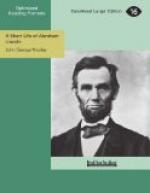I am thoroughly convinced that the closing struggle of the war will occur somewhere in this mountain country. By our superior numbers and strength we will everywhere drive the rebel armies back from the level districts lying along the coast, from those lying south of the Ohio River, and from those lying east of the Mississippi River. Yielding to our superior force, they will gradually retreat to the more defensible mountain districts, and make their final stand in that part of the South where the seven States of Virginia, North Carolina, South Carolina, Georgia, Tennessee, Kentucky, and West Virginia come together. The population there is overwhelmingly and devotedly loyal to the Union. The despatches from Brigadier-General Thomas of October 28 and November 5 show that, with four additional good regiments, he is willing to undertake the campaign and is confident he can take immediate possession. Once established, the people will rally to his support, and by building a railroad, over which to forward him regular supplies and needed reinforcements from time to time, we can hold it against all attempts to dislodge us, and at the same time menace the enemy in any one of the States I have named.
While his hearers listened with interest, it was evident that their minds were still full of the prospect of a great battle in Virginia, the capture of Richmond, and an early suppression of the rebellion. Railroad building appeared to them altogether too slow an operation of war. To show how sagacious was the President’s advice, we may anticipate by recalling that in the following summer General Buell spent as much time, money, and military strength in his attempted march from Corinth to East Tennessee as would have amply sufficed to build the line from Lexington to Knoxville recommended by Mr. Lincoln—the general’s effort resulting only in his being driven back to Louisville; that in 1863, Burnside, under greater difficulties, made the march and successfully held Knoxville, even without a railroad, which Thomas with a few regiments could have accomplished in 1861; and that in the final collapse of the rebellion, in the spring of 1865, the beaten armies of both Johnston and Lee attempted to retreat for a last stand to this same mountain region which Mr. Lincoln pointed out in December, 1861.
Though the President received no encouragement from senators and representatives in his plan to take possession of East Tennessee, that object was specially enjoined in the instructions to General Buell when he was sent to command in Kentucky.
“It so happens that a large majority of the inhabitants of eastern Tennessee are in favor of the Union; it therefore seems proper that you should remain on the defensive on the line from Louisville to Nashville, while you throw the mass of your forces by rapid marches by Cumberland Gap or Walker’s Gap on Knoxville, in order to occupy the railroad at that point, and thus enable the loyal citizens of eastern Tennessee to rise, while you at the same time cut off the railway communication between eastern Virginia and the Mississippi.”




